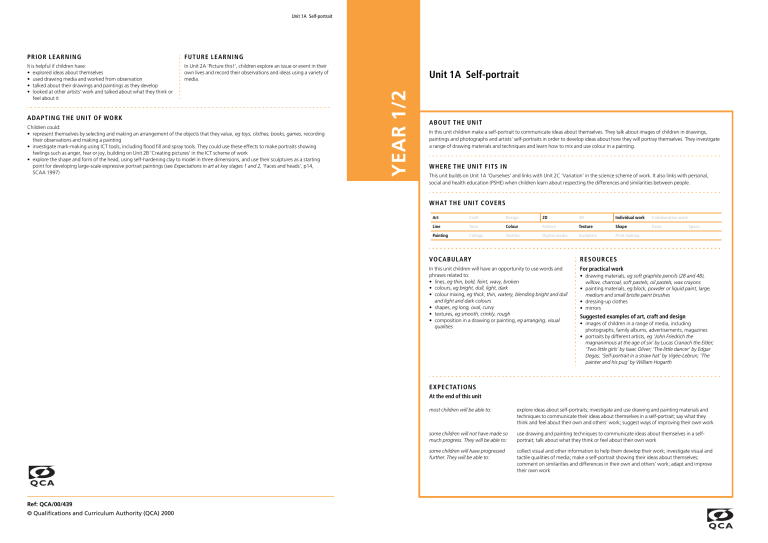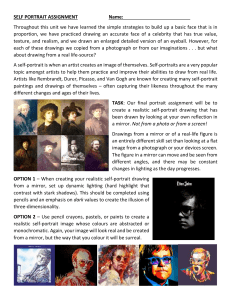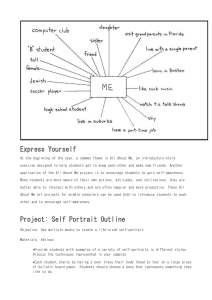
Unit 1A Self-portrait FUTURE L EARNING It is helpful if children have: • explored ideas about themselves • used drawing media and worked from observation • talked about their drawings and paintings as they develop • looked at other artists’ work and talked about what they think or feel about it In Unit 2A ‘Picture this!’, children explore an issue or event in their own lives and record their observations and ideas using a variety of media. ADAP TIN G THE UN IT O F WO RK Children could: • represent themselves by selecting and making an arrangement of the objects that they value, eg toys, clothes, books, games, recording their observations and making a painting • investigate mark-making using ICT tools, including flood fill and spray tools. They could use these effects to make portraits showing feelings such as anger, fear or joy, building on Unit 2B ‘Creating pictures’ in the ICT scheme of work • explore the shape and form of the head, using self-hardening clay to model in three dimensions, and use their sculptures as a starting point for developing large-scale expressive portrait paintings (see Expectations in art at key stages 1 and 2, ’Faces and heads’, p14, SCAA 1997) Unit 1A Self-portrait YEAR 1/2 P RIO R L EARN IN G AB OUT TH E U NIT In this unit children make a self-portrait to communicate ideas about themselves. They talk about images of children in drawings, paintings and photographs and artists’ self-portraits in order to develop ideas about how they will portray themselves. They investigate a range of drawing materials and techniques and learn how to mix and use colour in a painting. WHERE THE UNIT F ITS IN This unit builds on Unit 1A ‘Ourselves’ and links with Unit 2C ‘Variation’ in the science scheme of work. It also links with personal, social and health education (PSHE) when children learn about respecting the differences and similarities between people. WHAT T HE UNIT COVER S Art Craft Design 2D 3D Individual work Collaborative work Line Tone Colour Pattern Texture Shape Form Painting Collage Textiles Digital media Sculpture Print making VOC ABU LARY R ESOUR C ES In this unit children will have an opportunity to use words and phrases related to: • lines, eg thin, bold, feint, wavy, broken • colours, eg bright, dull, light, dark • colour mixing, eg thick, thin, watery, blending bright and dull and light and dark colours • shapes, eg long, oval, curvy • textures, eg smooth, crinkly, rough • composition in a drawing or painting, eg arranging, visual qualities For practical work Space • drawing materials, eg soft graphite pencils (2B and 4B), willow, charcoal, soft pastels, oil pastels, wax crayons • painting materials, eg block, powder or liquid paint, large, medium and small bristle paint brushes • dressing-up clothes • mirrors Suggested examples of art, craft and design • images of children in a range of media, including photographs, family albums, advertisements, magazines • portraits by different artists, eg ‘John Friedrich the magnanimous at the age of six’ by Lucas Cranach the Elder; ‘Two little girls’ by Isaac Oliver; ‘The little dancer’ by Edgar Degas; ‘Self-portrait in a straw hat’ by Vigée-Lebrun; ’The painter and his pug’ by William Hogarth EXPECTATIONS At the end of this unit Ref: QCA/00/439 © Qualifications and Curriculum Authority (QCA) 2000 most children will be able to: explore ideas about self-portraits; investigate and use drawing and painting materials and techniques to communicate their ideas about themselves in a self-portrait; say what they think and feel about their own and others’ work; suggest ways of improving their own work some children will not have made so much progress. They will be able to: use drawing and painting techniques to communicate ideas about themselves in a selfportrait; talk about what they think or feel about their own work some children will have progressed further. They will be able to: collect visual and other information to help them develop their work; investigate visual and tactile qualities of media; make a self-portrait showing their ideas about themselves; comment on similarities and differences in their own and others’ work; adapt and improve their own work Unit 1A Self-portrait E XPLOR I NG A ND DE VEL OPING IDEAS • about differences and similarities in the work of artists • Talk about selected images of children, raising questions about the ways in which the clothes worn, the pose and the activities shown, convey ideas about the children. • Talk about selected self-portraits focusing on how artists have conveyed ideas about themselves, eg how do the artists show themselves? As a painter? As a mother? As a friend? As a person with status? Ask the children to suggest why portraits are made, eg to record an important time in a person’s life, to project a powerful image of the person, to portray individuals as wealthy, knowledgeable or hard working. • identify differences in ways that children are represented in art • identify ways in which artists represent themselves and suggest reasons for this • Ask the children to collect photographs and other information about themselves at home, school and play. • Display images of children by painters, photographers and illustrators (including photographs of the children in the class) together with examples of artists’ self-portraits. • to ask and answer questions about the starting points for their work, and to develop their ideas • Focus the children’s attention on one self-portrait. Ask them to describe: – the person or people and the objects they are holding, wearing, etc (the content, subject) – the main shapes and colours, etc in the image (the visual elements and the composition) – how the image is made. Is it a photograph? A painting? A print? (materials and processes used) – how the image makes them feel about the person portrayed. What sort of person is this? What is the person doing? What does the image tell you about the person? (the ideas and meanings) • Ask the children to look at each other’s appearance, eg their height, shape, colour of skin and hair, facial features. Talk about how the children would show themselves in a portrait. What clothes would they be wearing? How would they like to be seen? What would they be doing? Would they include objects such as toys or a pet? • identify aspects of one self-portrait and say what they think and feel about it • identify ways in which children in the class are similar to and different from each other • suggest ideas about how to represent themselves • Develop strategies to give children confidence to talk about the work of artists. These could include focusing attention on one image and asking one or more children to adopt the pose of the sitter in the portrait, or using dressing-up clothes to replicate a portrait. • Links with National Literacy Strategy: Framework for teaching, year 1 vocabulary extension, where children learn new words from shared experiences. • Links with Unit 1A ‘Ourselves’ and Unit 2C ‘Variation’ in the science scheme of work where children learn about the similarities and differences between humans. It could also link to PSHE by helping children to learn to respect similarities and differences between people. • to investigate the possibilities of a range of materials and processes, including drawing • Ask the children to investigate a range of drawing media and the marks they can make, eg try out techniques for showing textures of hair, smoothness of skin, pattern on clothing. Encourage children to explore different types of marks, eg bold, expressive, quiet, wriggly. Ask them to use marks that communicate ideas about themselves and how they would like to be seen by others, eg big and bold, quiet and thoughtful. • experiment with and use drawing media and techniques to create a range of visual effects • Explain that the purpose of the activity is to learn about different drawing media, and to investigate different kinds of marks and how they might be used in their work. It is not to produce a finished drawing. • to try out tools and techniques and apply these to materials and processes, including drawing • Give the children mirrors. Ask them to look at themselves and think about the size and shape of their faces and about the size of parts of their face or body in relation to each other. • Ask them to draw life-size and miniature self-portraits, including themselves as a whole or just their head and shoulders. • record self-portraits from observation, working on different scales • Teach children how to organise their workspace, including setting out and packing away materials. Encourage children to think about how to use tools and materials safely and effectively. • to review what they have done • Display children’s work to show how they look different from one another. Put the images of children they talked about earlier alongside their work and talk about similarities and differences. Reinforce that the children can choose how to project themselves in their self-portraits, and show themselves as they wish to be seen. • comment on differences in others’ work • Encourage children to experiment with mixing colour and with controlling the consistency of the paint. Show them how to apply the colour in stages, deciding which parts they will treat as flat colour and which parts they will work and make more complex. • to represent observations, ideas and feelings, and design and make a painting • Using their drawings as a reference, ask the children to make a larger painting. Ask them to draw the outline and main shapes of the portrait using light-coloured chalk or a medium brush and a light colour. Show them how to mix paint and colour to represent skin, eyes, hair, etc. Demonstrate a system of colour mixing, eg combining two colours to achieve a range, adding black or white to make darker or lighter tones. • plan, compose and make a self-portrait painting • Provide opportunities for children to discuss their plans and think through the ideas they would like to convey. • Displaying children’s work can be part of the review process. It gives children the opportunity to compare their work with others in the class and can help them to learn from their successes as well as from their mistakes and difficulties. I NVE S T I GA T I NG AND MAK ING E VA LU A T I NG AND DE VEL OPING W OR K • to review what they and others have done and say what they think and feel about it • As a class, review the children’s drawings and paintings and the decisions they made. Talk about what they think has been most successful. What ideas about themselves and meanings did they want to convey? How have they represented themselves? What have they included in the portrait and why? What are they doing in their portrait? How have they used the media – drawing, paint? How have they used visual qualities such as line, colour, texture? What do they think about the techniques they have used? • use descriptive and expressive vocabulary to talk about their portrait work • to identify what they might change in their current work or develop in their future work • Ask the children to say what they would like to change about their work and what they think they would like to do in the future. How might they show themselves differently? What characteristics might they have portrayed instead? What would they like to show in a portrait of someone else? • identify the successful parts of their painting and explain why they think these parts are successful • identify what they might like to change or improve Unit 1A Self-portrait FUTURE L EARNING It is helpful if children have: • explored ideas about themselves • used drawing media and worked from observation • talked about their drawings and paintings as they develop • looked at other artists’ work and talked about what they think or feel about it In Unit 2A ‘Picture this!’, children explore an issue or event in their own lives and record their observations and ideas using a variety of media. ADAP TIN G THE UN IT O F WO RK Children could: • represent themselves by selecting and making an arrangement of the objects that they value, eg toys, clothes, books, games, recording their observations and making a painting • investigate mark-making using ICT tools, including flood fill and spray tools. They could use these effects to make portraits showing feelings such as anger, fear or joy, building on Unit 2B ‘Creating pictures’ in the ICT scheme of work • explore the shape and form of the head, using self-hardening clay to model in three dimensions, and use their sculptures as a starting point for developing large-scale expressive portrait paintings (see Expectations in art at key stages 1 and 2, ’Faces and heads’, p14, SCAA 1997) Unit 1A Self-portrait YEAR 1/2 P RIO R L EARN IN G AB OUT TH E U NIT In this unit children make a self-portrait to communicate ideas about themselves. They talk about images of children in drawings, paintings and photographs and artists’ self-portraits in order to develop ideas about how they will portray themselves. They investigate a range of drawing materials and techniques and learn how to mix and use colour in a painting. WHERE THE UNIT F ITS IN This unit builds on Unit 1A ‘Ourselves’ and links with Unit 2C ‘Variation’ in the science scheme of work. It also links with personal, social and health education (PSHE) when children learn about respecting the differences and similarities between people. WHAT T HE UNIT COVER S Art Craft Design 2D 3D Individual work Collaborative work Line Tone Colour Pattern Texture Shape Form Painting Collage Textiles Digital media Sculpture Print making VOC ABU LARY R ESOUR C ES In this unit children will have an opportunity to use words and phrases related to: • lines, eg thin, bold, feint, wavy, broken • colours, eg bright, dull, light, dark • colour mixing, eg thick, thin, watery, blending bright and dull and light and dark colours • shapes, eg long, oval, curvy • textures, eg smooth, crinkly, rough • composition in a drawing or painting, eg arranging, visual qualities For practical work Space • drawing materials, eg soft graphite pencils (2B and 4B), willow, charcoal, soft pastels, oil pastels, wax crayons • painting materials, eg block, powder or liquid paint, large, medium and small bristle paint brushes • dressing-up clothes • mirrors Suggested examples of art, craft and design • images of children in a range of media, including photographs, family albums, advertisements, magazines • portraits by different artists, eg ‘John Friedrich the magnanimous at the age of six’ by Lucas Cranach the Elder; ‘Two little girls’ by Isaac Oliver; ‘The little dancer’ by Edgar Degas; ‘Self-portrait in a straw hat’ by Vigée-Lebrun; ’The painter and his pug’ by William Hogarth EXPECTATIONS At the end of this unit Ref: QCA/00/439 © Qualifications and Curriculum Authority (QCA) 2000 most children will be able to: explore ideas about self-portraits; investigate and use drawing and painting materials and techniques to communicate their ideas about themselves in a self-portrait; say what they think and feel about their own and others’ work; suggest ways of improving their own work some children will not have made so much progress. They will be able to: use drawing and painting techniques to communicate ideas about themselves in a selfportrait; talk about what they think or feel about their own work some children will have progressed further. They will be able to: collect visual and other information to help them develop their work; investigate visual and tactile qualities of media; make a self-portrait showing their ideas about themselves; comment on similarities and differences in their own and others’ work; adapt and improve their own work



